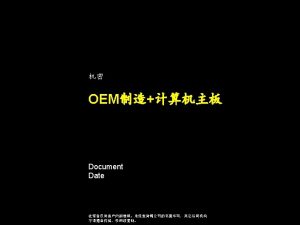Takhtajans System of Classification 1997 Armen Takhtajan who












- Slides: 12

Takhtajan’s System of Classification 1997

Armen Takhtajan who is the Head of the Department of Higher plants at the Komarov Botanical Institute in Leningrad, Russia, presented a system of classification, which was first published in a very preliminary form in 1942. The actual system however appeared in 1959 in German in his book Die Evolution der Angiosperm. After 1966. It was published in English in 1969 in Flowering Plants: Origin and Dispersal. A new version of the system has been published in Botanical Review recently in 1980. Takhtajan was inspired by Hailier’s attempt to create a synthetic evolutionary classification of flowering plants based on Darwinian philosophy and his approach is very much similar to that of Cronquist.

Armen Takhtajan’s System of Classification: Takhtajan’s system of classification is basically of Bessey-Hallier tradition which considered all evidences from different fields including morphological, anatomical, embryological, cytological, palynological, paleobotanical, chemical and ultrastructural evidences while classifying Angiosperms. He considered Angiosperms to be monophyletic in origin and that they arose from some ancient group of Gymnosperms. The Monocotyledons are, considered to have been derived from primitive Dicotyledons.

Takhtajan divided the Magnoliophyta (Angiosperms) into two Classes – Magnoliopsida (Dicotyledons) Liliopsida (Monocotyledons) Of which Magnoliopsida is considered primitive and Liliopsida to have been derived from Magnoliales under Magnoliopsida.

However according to Takhtajan’s system of classification, 1997, the two Classes have been divided into 15 Subclasses, 11 under the Magnoliopsida and 5 under Liliopsida, which are as follows:



Merits of Takhtajan’s System of Classification: Takhtajan’s system was not much cared of when it first appeared in 1959. However since its publication in the revised form in English in 1969, it has attracted the attention of the entire world and is considered one of the most satisfactory phylogenetic system, which is followed in many parts of the world. This system is largely accepted mainly due to its clearly defined evolution principles and has the following plus points to its credit: (a) The Dicots (Magnoliopsida) has been discussed prior to Monocots (Liliopsida). (b) The families are small homogeneous units made up of closely related genera.

(c) The Dicots begin with Magnoliales; which is highly satisfactory as Magnoliales are universally considered to be the most primitive living Angiosperms. (d) Among Monocots, the Alismatales, which are considered to be the most primitive living Monocots, have been placed at the starting point, which is, satisfactory. (e) Engler and Prantl’s division of Dicots into two traditional groups – Archichlamydae and Metachlamydae, has been abolished in this system. (f) Problems such as monophyly or polyphyly, interrelationships of Dicots and Monocots, primitive position of Magnoliales, the secondary nature of anemophilous families with reduced unisexual flowers, etc. have been satisfactorily settled.

Demerits of Takhtajan’s System of Classification: (a) The main objection to Takhtajan’s system is his derivation of Monocotyledons from the stocks ancestral to the Nymphaeales. (b) The extremely narrowly defined taxa in this system has resulted in the unwarranted splitting of related groups. c) Hamameltdidae do not represent an ancient side branch of Magniliidae d) Most authors regard the vessel less family Winteraceae as primitive, but Takhtajan regarded Degeneriaceae as primitive

Takhtajan’s system is based on 67 phyletic principles. Some of the important criteria used by him to evaluate the relative degree of advancement of flowering plants are as follows: 1. Woody plants are primitive than herbaceous plants. 2. Deciduous woody plants are considered evolved from evergreen plants. 3. Xylem fibers evolved from tracheids to libriform fibres, through fibre tracheids. 4. Trilacunar or pentalacunar nodes are primitive to unilacunar nodes. 5. Alternate leaf arrangement is primitive while parallel venation is most advanced. 6. Stomata with subsidiary cells are primitive than those lacking subsidiary cells. .

7. Cymose inflorescence is primitive than racemose. 8. Flowers with an indefinite or variable number of floral parts are primitive. 9. Pollen with un-sculptured exine is primitive to sculptured pollen. 10. Apocarpous gynoecium is primitive. 11. Bitegmic ovules are primitive than unitegmic ovules, while anatropous ovule is most primitive. 12. 8 -nucleated Polygonum type female gametophyte is most primitive. 13. Mesogamic and Chalazogamic conditions have evolved from Porogamic condition. 14. Among fruits many-seeded follicle is most primitive























